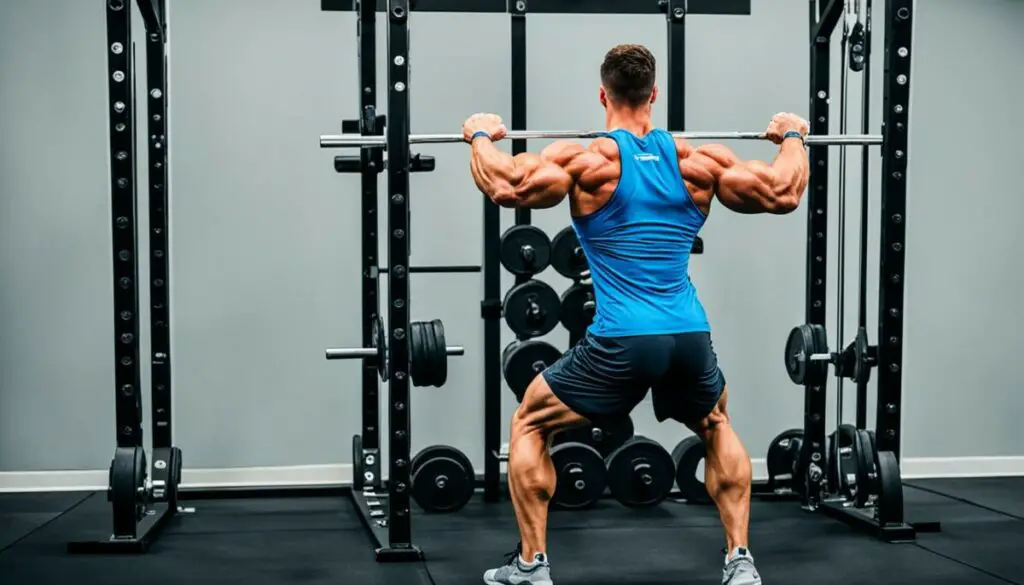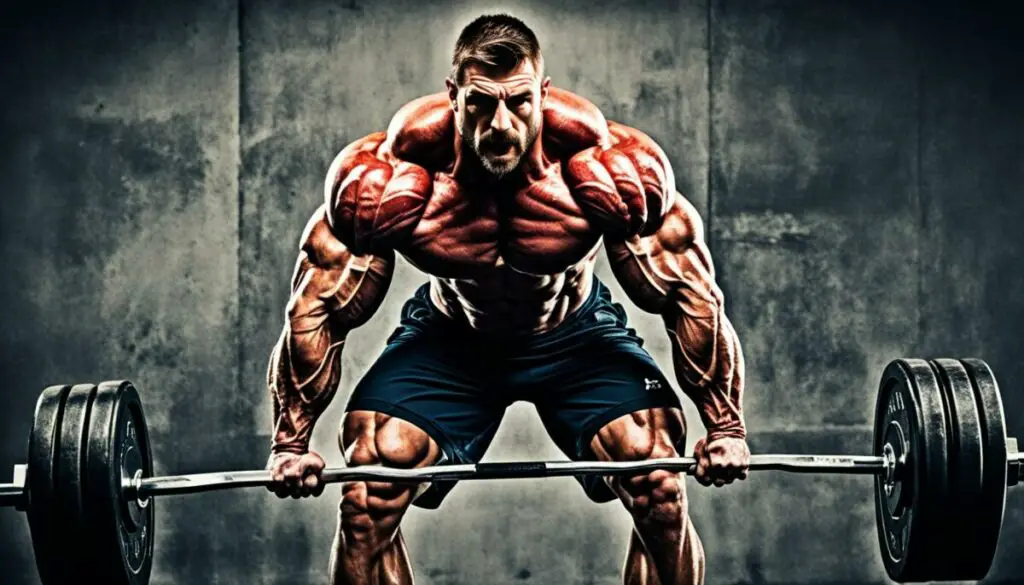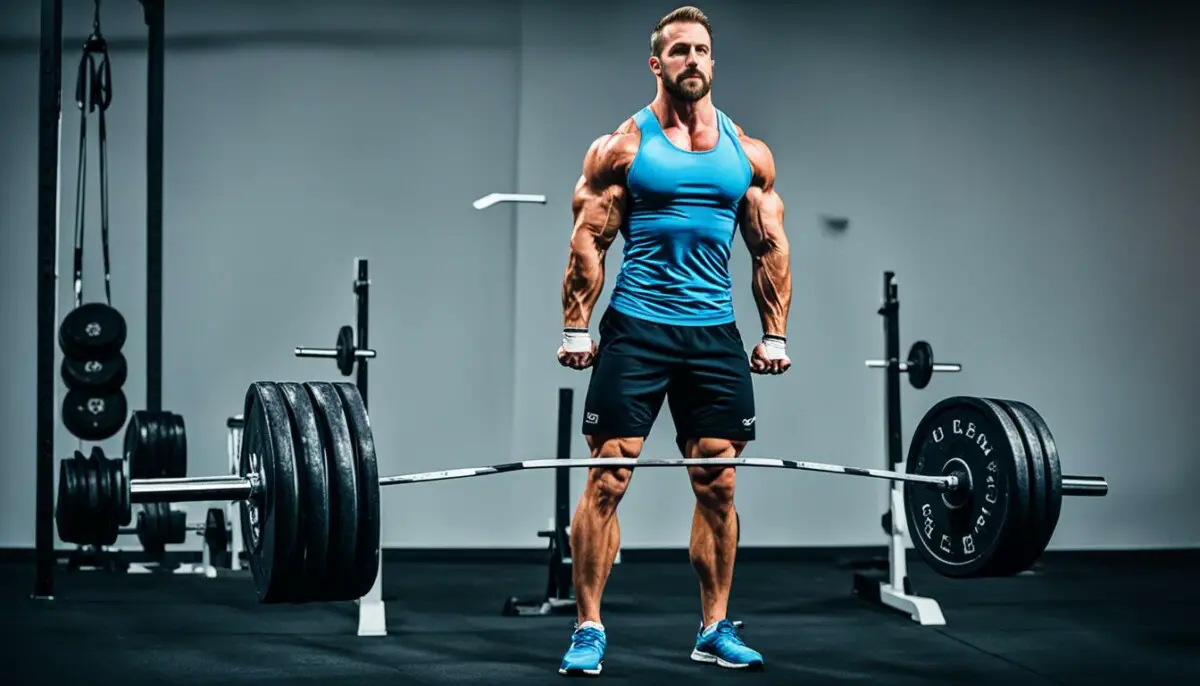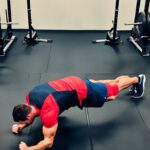Last Updated on 3 months by Francis
The trap bar Romanian deadlift, also known as the trap bar RDL, is a powerful exercise that can take your deadlift game to the next level. This variation of the trap bar deadlift is a great way to strengthen your legs, improve lower body power, and enhance your overall fitness.
Whether you’re an experienced athlete looking to maximize your deadlift performance or a beginner eager to build strength, the trap bar RDL is a versatile exercise that can benefit anyone. In this article, we will explore the benefits of trap bar deadlift variations, learn the proper form, and discover how to incorporate them into your training program.
Contents
Key Takeaways:
- Trap bar RDLs are an effective way to improve leg strength and lower body power.
- Proper form is essential to get the most out of trap bar deadlifts.
- Trap bar RDLs target multiple muscle groups, including the glutes, hamstrings, quadriceps, erector spinae, and traps.
- They can be incorporated into various training programs for athletes of all levels.
- Gradually increasing intensity and focusing on proper technique will maximize the benefits of trap bar RDLs.
How to Do the Trap Bar Deadlift

The trap bar deadlift is a compound exercise that engages multiple muscle groups, making it an effective choice for building strength and improving overall fitness. To perform the trap bar deadlift correctly and maximize its benefits, follow these steps:
Step 1: Set Up and Bracing
Begin by positioning the trap bar on the ground in front of you. Stand in the center of the frame, ensuring that the bar is aligned with your midfoot. Take a hip-width stance with your toes pointing slightly outward. Bend at your hips and knees, lowering yourself down to grip the handles of the trap bar with a double overhand grip or a mixed grip (one palm facing towards you, the other palm facing away).
Step 2: Initiate the Movement
Before lifting the bar, take a deep breath and brace your core. This will help stabilize your spine and protect your lower back. Push down through your feet, driving your hips forward and extending your knees to lift the trap bar off the ground. Keep your chest up, shoulders back, and maintain a neutral spine throughout the entire movement.
Step 3: Maintain Tension
As you stand up with the trap bar, focus on maintaining tension in your entire body. Squeeze your glutes, engage your core, and keep your shoulders pulled back. Avoid rounding your back or letting your shoulders slump forward. Maintain a strong and stable posture as you stand up fully.
Note: It’s important to use a weight that allows you to maintain proper form throughout the exercise. If you’re new to trap bar deadlifts, start with lighter weights and gradually increase the load as you become more comfortable and confident with the movement.
Remember, the trap bar deadlift is a dynamic movement that requires focus, control, and proper technique. By following these steps and paying attention to your form, you can safely and effectively perform the trap bar deadlift and reap its benefits.
Benefits of the Trap Bar Deadlift

The trap bar deadlift offers several benefits. It can be used as an entry-level deadlift practice for beginners to increase lower body strength and improve pulling performance. It also helps in building foundational pulling strength and muscle mass. Additionally, the trap bar deadlift allows for decreased lumbar stress, increased leg and glute hypertrophy, and the ability to overload the nervous system with heavy weights.
The Benefits of Trap Bar Deadlifts
The benefits of incorporating trap bar deadlifts into your training program are numerous. Here are the key advantages:
- Increased Lower Body Strength: Trap bar deadlifts target the major muscle groups in the lower body, including the quads, hamstrings, and glutes. Performing this exercise regularly will improve overall leg strength.
- Improved Pulling Performance: By focusing on proper form and technique, trap bar deadlifts can help you become a better puller in other exercises, such as conventional deadlifts or cleans.
- Building Pulling Strength: The trap bar deadlift is an effective way to build foundational pulling strength, as it engages the muscles in your back, shoulders, and arms.
- Muscle Mass Gain: Due to the compound nature of the trap bar deadlift, it stimulates the growth of multiple muscle groups, leading to overall muscle hypertrophy.
- Reduced Lumbar Stress: The design of the trap bar allows for a more upright posture, reducing stress on the lower back. This makes it a suitable alternative for individuals with lower back issues.
- Hypertrophy of Leg and Glute Muscles: Trap bar deadlifts place a significant load on the muscles of your legs and glutes, promoting growth and strength development.
- Nervous System Overload: Due to the ability to handle heavier weights, trap bar deadlifts provide an opportunity to challenge your nervous system and develop a greater capacity for handling heavy loads.
By incorporating trap bar deadlifts into your training routine, you can experience these benefits and take your strength and fitness to the next level.
Muscles Worked by the Trap Bar Deadlift

The trap bar deadlift is an effective compound exercise that targets multiple muscle groups, providing a comprehensive workout for your lower body and upper back. Here are the key muscles worked during trap bar deadlifts:
- Glutes: The trap bar deadlift heavily engages the gluteus maximus, the largest muscle in the buttocks, which is responsible for hip extension and power generation.
- Hamstrings: This exercise activates the hamstrings, which are a group of muscles located at the back of the thigh. They play a crucial role in knee flexion and hip extension.
- Quadriceps: While the emphasis is on the posterior chain, the quadriceps, located at the front of the thigh, are still engaged during trap bar deadlifts to stabilize the knee joint and assist in the movement.
- Erector Spinae: The erector spinae muscles, located on either side of the spinal cord, are responsible for back extension and play a significant role in maintaining an upright posture throughout the lift.
- Traps: The trapezius muscles, located in the upper back and neck region, are activated during the trap bar deadlift to stabilize the scapulae and assist in maintaining proper posture.
It’s important to note that individual form and technique may influence the level of muscle activation in each specific muscle group.
| Muscle Group | Primary Function |
|---|---|
| Glutes | Hip extension |
| Hamstrings | Knee flexion, hip extension |
| Quadriceps | Knee stabilization, hip extension |
| Erector Spinae | Back extension, posture maintenance |
| Traps | Scapulae stabilization, posture maintenance |
Who Should Do the Trap Bar Deadlift

The trap bar deadlift is a versatile exercise that can be a valuable addition to the training routines of various individuals. Whether you are a strongman, powerlifter, Olympic weightlifter, CrossFit athlete, fitness enthusiast, or a beginner looking to improve your fitness level, the trap bar deadlift offers broad applicability and benefits for different training goals and abilities.
Unlike traditional barbell deadlifts, the trap bar deadlift allows for a more natural grip and an alignment of the weight closer to the center of mass, which can contribute to a more upright posture and decreased lumbar stress. This makes it an excellent foundational movement pattern for beginners before progressing to more technical deadlift variations.
The trap bar deadlift targets multiple muscle groups, including the glutes, hamstrings, quadriceps, erector spinae, and traps. It can help build lower body strength, improve pulling performance, and promote leg and glute hypertrophy. Additionally, it allows for the ability to handle heavy loads and overload the nervous system, making it an attractive exercise for strength and power development.
Overall, the trap bar deadlift is suitable for individuals across different disciplines and fitness levels. It provides a safe and effective way to train lower body strength, improve pulling mechanics, and enhance athletic performance. Whether you aim to compete in strength sports or simply want to enhance your overall fitness, incorporating the trap bar deadlift into your training program can be highly beneficial.
| Who Should Do Trap Bar Deadlifts: |
|---|
| Beginners |
| Strongmen |
| Powerlifters |
| Olympic weightlifters |
| CrossFit and fitness athletes |
Whether you are starting your fitness journey or looking to take your training to the next level, the trap bar deadlift is a highly versatile exercise that can help you achieve your goals. By targeting multiple muscle groups, improving pulling mechanics, and promoting strength and power development, the trap bar deadlift offers a valuable training stimulus for a wide range of individuals.
Trap Bar Deadlift Sets and Reps
The number of sets, repetitions, and weight recommendations for trap bar deadlifts can vary based on individual goals and training experience. Whether you’re a beginner looking to build lower body strength or an advanced lifter focusing on strength and technique, tailoring your sets and reps is crucial.
For Beginners:
For individuals new to trap bar deadlifts, it’s recommended to start with lighter weights to focus on proper form and develop pulling mechanics. Aim for 3-4 sets of 8-10 repetitions.
Example:
| Level | Sets | Repetitions | Weight |
|---|---|---|---|
| Beginner | 3-4 | 8-10 | Lighter weights |
Start with a weight that allows you to maintain proper form and gradually increase the weight as you become more comfortable and confident with the exercise.
For Advanced Lifters:
Advanced lifters can handle heavier loads and focus on strength and technique. Give priority to heavier weights and lower rep ranges to promote strength gains. Aim for 3-5 sets of 4-6 repetitions.
Example:
| Level | Sets | Repetitions | Weight |
|---|---|---|---|
| Advanced | 3-5 | 4-6 | Heavy weights |
Keep in mind that as the weight increases, maintaining proper form and technique becomes even more important. Listen to your body and adjust the weight accordingly.
Remember, the key is to find the right balance between intensity and safety, allowing for progressive overload and continuous improvement. Stay consistent with your training regimen and adjust the sets, reps, and weights based on your individual progress and goals.
Trap Bar Deadlift Variations
Looking to spice up your training routine and challenge your muscles in new ways? Incorporating trap bar deadlift variations into your workouts can add variety and keep your progress moving forward. Check out some of the best trap bar RDL variations and trap bar deadlift variations below.
Rack Pulls
If you want to focus on building strength in your upper back and improve your lockout at the top of the deadlift, rack pulls are an excellent option. Set up the trap bar on adjustable safety bars or pins at knee height or slightly above. Perform the lift by starting in a standing position with the bar at knee level or above and pulling up until you achieve full extension.
Resisted Deadlifts with Bands
To increase the challenge and difficulty of your trap bar deadlifts, try incorporating resistance bands. By attaching bands to each end of the trap bar and stepping on them during the lift, you’ll experience increased tension throughout the movement. This variation helps improve explosiveness and power.
Romanian Deadlifts (RDLs)
The Romanian deadlift (RDL) variation with the trap bar is an effective way to target the posterior chain, including the hamstrings, glutes, and lower back. Start by gripping the handles with a hip-width stance, then hinge at the hips while keeping your back straight and core tight. Lower the bar towards the ground while maintaining tension in the hamstrings, and return to the starting position.
Integrating these trap bar deadlift variations into your training regimen can help you target different muscle groups and address specific weaknesses or plateaus. Experiment with different variations to find which ones work best for your goals and fitness level.
| Variation | Muscles Targeted | Main Benefits |
|---|---|---|
| Rack Pulls | Upper back, traps, posterior chain | Improved lockout, upper body strength |
| Resisted Deadlifts with Bands | Full body, especially explosive power | Increased resistance throughout the movement, improved explosiveness |
| Romanian Deadlifts (RDLs) | Hamstrings, glutes, lower back | Targeted posterior chain development, improved hip hinge mechanics |
Remember to prioritize proper form and technique when performing any trap bar deadlift variation. Start with lighter weights and gradually increase the load as you become more comfortable and confident. As always, listen to your body and consult with a fitness professional if you have any questions or concerns.
Common Mistakes and How to Polish Technique
While performing trap bar deadlifts, it’s important to be aware of common mistakes that may hinder your progress and increase the risk of injury. By addressing these mistakes and focusing on proper technique, you can maximize the benefits of the exercise and improve your overall performance. Here are some common mistakes to avoid and strategies to help you polish your trap bar RDL technique:
Rounding the Back
One of the most common mistakes in trap bar deadlifts is rounding the back. This can lead to spinal stress and compromise your form. To avoid this, make sure to engage your core and maintain a neutral spine throughout the lift. Imagine a straight line from your head to your tailbone and focus on keeping your back flat.
Rising Hips Too Fast
Another mistake is rising the hips too quickly during the lift. This can shift the load away from the targeted muscles and limit the effectiveness of the exercise. Instead, focus on initiating the movement with your legs and driving through the hips in a controlled manner. This will help you maintain proper alignment and engage the right muscle groups.
Leaning Back Excessively at the Top
Leaning back excessively at the top of the lift is another common mistake that can put unnecessary stress on your lower back. Instead, focus on standing tall and maintaining a straight line from your heels to your head. Avoid hyperextending your back and aim for a strong, stable position.
Tilting the Bar During the Lift
Tilting the bar during the lift is a mistake that can affect the balance and stability of the movement. To avoid this, make sure to grip the handles evenly and maintain a symmetrical position throughout the lift. Focus on keeping the bar aligned with your midfoot and avoid any excessive tilting.
By addressing these common trap bar deadlift mistakes, you can improve your technique and optimize your training. Remember to focus on proper setup, strengthen your core and back muscles, improve hip extension, and maintain control throughout the movement. With consistent practice and attention to detail, you’ll be able to perform trap bar RDLs with confidence and efficiency.
| Mistake | Correction |
|---|---|
| Rounding the Back | Engage core and maintain a neutral spine |
| Rising Hips Too Fast | Initiate movement with legs and drive through hips |
| Leaning Back Excessively at the Top | Maintain a straight line from heels to head |
| Tilting the Bar During the Lift | Grip handles evenly and keep the bar aligned |
Supramaximal Trap Bar Deadlifts and Injury Prevention
Supramaximal trap bar deadlifts, performed with loads of 80% or higher, can be an effective technique to challenge your body and promote hamstring fascicle lengthening. This exercise is particularly beneficial for hamstring injury prevention and strengthening. To ensure safety and maximize the benefits, it’s crucial to focus on proper trap bar RDL technique, follow a gradual progression, and prioritize core stability.
Performing supramaximal trap bar deadlifts can push your limits and unlock new levels of strength. By lifting heavy loads, you engage your entire body, including the legs, glutes, back, and core. This compound movement places significant stress on the hamstrings, increasing their fascicle length and strengthening them over time.
However, it’s important to approach supramaximal trap bar deadlifts with caution to avoid injury. Pay close attention to your trap bar RDL technique, ensuring that your form is impeccable. Maintain a neutral spine, engage your core, and initiate the movement by hinging at the hips.
Gradual progression is key when incorporating supramaximal trap bar deadlifts into your routine. Start with lighter loads and gradually increase the weight as you build strength and confidence. This approach allows your body to adapt to the increasing demands and reduces the risk of overexertion or strain.
Core stability plays a vital role in performing supramaximal trap bar deadlifts safely and effectively. A strong and stable core helps maintain proper alignment and transfer force from your lower body to the bar. Incorporate exercises to strengthen your core, such as planks, Russian twists, and anti-rotation exercises, into your training routine.
Conclusion
Trap bar RDLs are a highly effective exercise that should be included in any comprehensive training program. By incorporating trap bar deadlift variations, you can experience a wide range of benefits and target multiple muscle groups simultaneously.
Whether you’re a beginner looking to build lower body strength or an experienced lifter aiming to improve overall athletic performance, trap bar RDLs provide a versatile and efficient solution. By focusing on proper form, gradually increasing intensity, and listening to your body, you can maximize the benefits of this exercise.
Remember, the trap bar deadlift is a dynamic movement that helps improve overall strength, muscle gain, and power. It engages the glutes, hamstrings, quadriceps, erector spinae, and traps, making it a compound exercise with immense benefits. Incorporating trap bar deadlift variations into your routine can help you reach new levels of performance and achieve your fitness goals.
FAQ
What are trap bar RDLS?
Trap bar RDLS, or trap bar Romanian deadlifts, are a variation of the deadlift exercise performed with a trap bar. They involve standing within the frame of the trap bar, gripping the handles, and performing a hip hinge movement to target the hamstrings and glutes.
How do you do trap bar RDLS?
To perform trap bar RDLS, stand inside the trap bar frame and grip the handles. Bend at the hips while keeping your back straight, pushing your hips back until you feel a stretch in your hamstrings. Then, push through your heels to return to the starting position, focusing on contracting your glutes and hamstrings throughout the movement.
What are the benefits of trap bar RDLS?
Trap bar RDLS can improve lower body strength, target the hamstrings and glutes, enhance pulling performance, and contribute to overall muscle gain and athletic performance. They also allow for a more upright posture, reducing lumbar stress compared to conventional deadlifts.
Which muscles are worked by trap bar RDLS?
Trap bar RDLS primarily target the glutes and hamstrings, while also working the quadriceps, erector spinae, and traps. The emphasis is on the posterior chain, making it a great exercise for developing lower body strength and muscularity.
Who should do trap bar RDLS?
Trap bar RDLS are suitable for a wide range of individuals, including strongmen, powerlifters, Olympic weightlifters, CrossFit and fitness athletes, as well as beginners. They can be used to build foundational pulling strength, improve pulling mechanics, and promote muscle growth.
What sets and reps should I do for trap bar deadlifts?
The number of sets, repetitions, and weight recommendations for trap bar RDLS can vary based on individual goals and training experience. Beginners can start with 3-4 sets of 8-10 repetitions using lighter weights, while more advanced lifters can use heavier loads and lower rep ranges for strength-focused training.
What are some trap bar deadlift variations?
There are several trap bar deadlift variations you can incorporate into your training. Some popular options include trap bar rack pulls, trap bar resisted deadlifts using bands, and different grip or stance variations. These variations target different muscle groups and provide specific benefits based on individual needs.
What are common mistakes in trap bar RDLS and how can I fix them?
Common mistakes in trap bar RDLS include rounding the back, rising hips too fast, leaning back excessively at the top, and tilting the bar during the lift. To address these issues, focus on proper setup and bracing, strengthen your core and back muscles, improve hip extension, and maintain control throughout the movement.
How can supramaximal trap bar deadlifts help with injury prevention?
Supramaximal trap bar deadlifts, performed with loads of 80% or higher, can challenge the entire body and promote hamstring fascicle lengthening. This can be beneficial for hamstring injury prevention and strengthening. When performing supramaximal trap bar deadlifts, it is important to maintain proper technique, gradually progress, and prioritize core stability.
Why should I incorporate trap bar RDLS into my training program?
Trap bar RDLS offer a range of benefits, including improved lower body strength, muscle gain, pulling mechanics, and athletic performance. Whether you’re a beginner or an experienced lifter, incorporating trap bar deadlift variations can help you achieve your training goals and enhance overall fitness.









